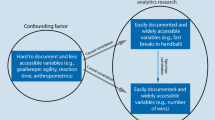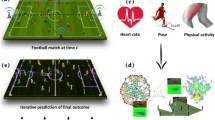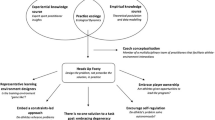Abstract
Background
Learning transfer is defined as an individual’s capability to apply prior learnt perceptual, motor, or conceptual skills to a novel task or performance environment. In the sport sciences, learning transfers have been investigated from an athlete-specific perspective. However, sport scientists should also consider the benefits of cross-disciplinary learning to aid critical thinking and metacognitive skill gained through the interaction with similar quantitative scientific disciplines.
Objective
Using team sports performance analysis as an example, this study aimed to demonstrate the utility of a common analytical technique in ecology in the sports sciences, namely, nonmetric multidimensional scaling.
Methods
To achieve this aim, three novel research examples using this technique are presented, each of which enables the analysis and visualization of athlete (organism), team (aggregation of organisms), and competition (ecosystem) behaviors.
Results
The first example reveals the technical behaviors of Australian Football League Brownlow medalists from the 2001 to 2016 seasons. The second example delineates dissimilarity in higher and lower ranked National Rugby League teams within the 2016 season. Lastly, the third example shows the evolution of game play in the basketball tournaments between the 2004 and 2016 Olympic Games.
Conclusions
In addition to the novel findings of each example, the collective results demonstrate that, by embracing cross-disciplinary learning and drawing upon an analytical technique common to ecology, novel solutions to pertinent research questions within sports performance analysis could be addressed in a practically meaningful way. Cross-disciplinary learning may subsequently assist sport scientists in the analysis and visualization of multivariate datasets.




Similar content being viewed by others
References
Magill RA, Anderson DI. Motor learning and control: concepts and applications. 10th ed. Columbus: McGraw-Hill Education; 2014.
Woodworth RS, Thorndike EL. The influence of improvement in one mental function upon the efficiency of other functions. Psychol Rev. 1901;8:247–61.
Causer J, Ford PR. “Decisions, decisions, decisions”: transfer and specificity of decision-making skill between sports. Cogn Process. 2014;15:385–9.
Adolph KE. Learning in the development of infant locomotion. Monogr Soc Res Child Dev. 1997;62:1–158.
Lindeblad E, Nilsson S, Gustafson S, Svensson I. Assistive technology as reading interventions for children with reading impairments with a one-year follow up. Disabil Rehabil Assist Technol. 2017;12(7):713–24.
Breckwoldt J, Lingemann C, Wagner P. Resuscitation training for lay persons in first aid courses: transfer of knowledge, skills and attitude. Anaesthesist. 2016;65:22–6.
Bonney E, Jelsma D, Ferguson G, Smits-Engelsman B. Variable training does not lead to better motor learning compared to repetitive training in children with and without DCD when exposed to active video games. Res Dev Disabil. 2017;62:124–36.
Rienhoff R, Hopwood MJ, Fischer L, Strauss B, Baker J, Schorer J. Transfer of motor and perceptual skills from basketball to darts. Front Psychol. 2013;12:593.
Bullock N, Gulbin JP, Martin DT, Ross A, Holland T, Marino F. Talent identification and deliberate programming in skeleton: ice novice to winter Olympian in 14 months. J Sports Sci. 2009;15:397–404.
Seifert L, Wattebled L. L’hermette M, Bideault G, Herault R, & Davids K. Skill transfer, affordances and dexterity in different climbing environments. Hum Mov Sci. 2013;32:1339–52.
MacNamara A, Collins D. Second chances: investigating athletes’ experiences of talent transfer. PLoS One. 2015;10(11):e0143592. doi:10.1371/journal.pone.0143592.
Halson S, Martin DT, Gardner AS, Fallon K, Gulbin J. Persistent fatigue in a female sprint cyclist after a talent-transfer initiative. Int J Sports Physiol Perform. 2006;1:65–9.
Ivanitskaya L, Clark D, Montgomery G, Primeau R. Interdisciplinary learning: process and outcomes. Innov High Educ. 2002;27:95–111.
Duarte R, Araújo D, Correia V, Davids K. Sports teams as superorganisms: implications for sociobiological models of behaviour for research and practice in team sports performance analysis. Sports Med. 2012;42:633–42.
De’arth G, Fabricius KE. Classification and regression trees: a powerful yet simple technique for ecological data analysis. Ecology. 2000;81:3178–92.
Stein M, Janetzko H, Seebacher D, et al. How to make sense of team sport data: from acquisition to data modelling and research aspects. Data. 2017;. doi:10.3390/data2010002.
Kenkel NC, Orloci L. Applying metric and nonmetric multidimensional scaling to ecological studies: some new results. Ecology. 1986;67:919–28.
Hout MC, Goldinger SD, Brady KJ. MM-MDS: a multidimensional scaling database with similarity ratings for 240 object categories from the massive memory picture database. PLoS One. 2014;. doi:org/10.1371/journal.pone.0112644.
Oksanen J, Blanchet GF, Kindt R, et al. Vegan: community ecology package. 2015. https://cran.r-project.org/web/packages/vegan. Accessed 22 Feb 2017.
Coutts AJ, Quinn J, Hocking J, Castagna C, Rampinini E. Match running performance in elite Australian rules football. J Sci Med Sport. 2009;13:543–8.
Dawson B, Hopkinson R, Appleby B, Stewart G, Roberts C. Player movement patterns and game activities in the Australian football league. J Sci Med Sport. 2004;7:278–91.
Woods CT, Raynor AJ, Bruce L, McDonald Z, Robertson S. The application of a multidimensional approach to talent identification in Australian football. J Sports Sci. 2016;34:1340–5.
Wickham H. Package ‘ggplot2’. 2016. https://cran.r-project.org/web/packages/ggplot2. Accessed 22 Feb 2017.
Gabbett TJ. Effects of physical, technical, and tactical factors on final ladder position in semiprofessional rugby league. Int J Sports Physiol Perform. 2014;9:680–8.
Gauch HG. Multivariate analysis and community structure. Cambridge: Cambridge University Press; 1982.
Gomez MA, Lorenzo A, Sampaio J, Ibanez SJ, Ortega E. Game-related statistics that discriminant winning and losing teams from the Spanish men’s professional basketball teams. Coll Antropol. 2008;32:315–9.
Scanlan AT, Dascombe BJ, Reaburn P, Dalbo VJ. The physiological and activity demands experienced by Australian female basketball players during competition. J Sci Med Sport. 2012;15:341–7.
Pion J, Hohmann A, Liu T, Lenoir M, Segers V. Predictive models reduce talent development costs in female gymnastics. J Sport Sci. 2017;35:806–11.
Bourdon PC, Cardinale M, Murray A, et al. Monitoring athlete training loads: consensus statement. Int J Sports Physiol Perform. 2017;12:161–70.
Mann D, Dehgansai N, Baker J. Searching for the elusive gift: advances in talent identification in sport. Curr Opin Psychol. 2017;16:128–33. doi:10.1016/j.copsyc.2017.04.016.
Cutler DR, Edwards TC, Beard KH, Cutler A, Hess KT, Gibson J, Lawler JJ. Random forests for classification in ecology. Ecology. 2007;88:2783–92.
Huang W, Nakamori Y, Wang SY. Forecasting stock market movement direction with support vector machine. Comput Oper Res. 2005;32:2513–22.
Author information
Authors and Affiliations
Corresponding author
Ethics declarations
Conflicts of interest
Carl T. Woods, Sam Robertson, Neil French Collier, Anne L. Swinbourne, and Anthony S. Leicht have no conflicts of interest.
Funding
No funding was acquired or provided during the completion of this work.
Electronic supplementary material
Below is the link to the electronic supplementary material.
Rights and permissions
About this article
Cite this article
Woods, C.T., Robertson, S., Collier, N.F. et al. Transferring an Analytical Technique from Ecology to the Sport Sciences. Sports Med 48, 725–732 (2018). https://doi.org/10.1007/s40279-017-0775-2
Published:
Issue Date:
DOI: https://doi.org/10.1007/s40279-017-0775-2




